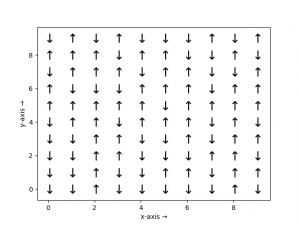Intuition of Ising 2D Model
Before we proceed with the exploration, let you rejoice with the historical background of Ising Model.
Spontaneous magnetization is a very peculiar property of the ferromagnetic material. So, many physicists in the early twentieth century found this phenomenon curious. Physicists lacked a good theoretical model until Ernst Ising introduced one now known as the “Ising Model”, in 1925. But, the credit goes to his doctoral advisor Wilhelm Lenz, who gave it as a problem to him. It is believed that Lenz had this idea first in 1920. I shall quote here the English translated resume 1 from his Dissertation:
I, Ernst Ising, was born on May 10, 1900, the son of the merchant Gutsav Ising and his wife Thekla, at Löwe, Köln. Shortly thereafter my parents moved to Bochum, Westfall, where I started school in Easter 1907. I received my diploma at the Gymnasium there, in 1918. After brief military training, I began my studies of mathematics and physics at Göttingen University in Easter 1919. After an absence of one semester, I continued my studies in Bonn, where I studied astronomy among other things. Two semesters later I went to Hamburg. There I turned especially to the study of theoretical physics at the suggestion of Professor Dr. W. Lenz, and at the end of 1922, I began under his guidance the investigation of ferromagnetism which led to the results presented here.
Ernst Ising’s analysis of a linear chain of two-state spins (i.e. +1 and -1 ) using his eponymous model was unusual at that time. His work on the one-dimensional system showed there was no phase transition at finite temperature. He then concluded that there will not be a phase transition in higher dimensional systems. He asserted this conclusion without any mathematical proof, simply extrapolating from his one-dimensional result. This statement proved to be erroneous, as demonstrated by Lars Onsager in the two-dimension version of the model. This discovery garnered much attention and Ising found himself an unexpected celebrity.
Now, we are ready to explore the basic intuition of this model.
At the same time, Stern and Gerlach were working in the same institute on their famous experiment on the quantization of the magnetic field of an electron. The idea so far developed was that the atom which has magnetic property consists with magnetic dipoles, and these dipoles have a limited number of orientations (i.e spin up and spin down). With this concept, Ising assumed the field created by these dipoles will only result from the interaction between the atoms and damped very soon.
So, our first question will be, How one atom’s spin will interact with other spins?
Suppose, we have a two-dimensional sheet of paper at which on each lattice there are either one of the spins. We assume spin up (+1) by the up arrow and spin down (-1) by the down arrow in the below figure:

Now, we randomly choose any one spin from the lattice. Either it will be spin up or spin down. By luck, we chose to spin up (say). Again our second question will be, What is the probability that the next randomly chosen spin will be spin up? Before answering this question, let’s modify our question as, If there is no any interaction between the spins then, what is the probability that the next randomly chosen spin will be spin up? Surely! It’s one-half because there is an equal probability for both the spin alignments. Now, let’s answer our previous unmodified question! Rely on Ising assumption, we can say the probability to be greater than one-half because firstly we have chosen spin up and its field will affect to the next randomly picked spin as well.
Again, Let’s make our question interesting! What if the first randomly chose spin is spin down! Now, What will be the probability of that spin which we have said earlier that, it is greater than one-half? Logically, It’s lesser than one-half [Think about for convincing yourself with this answer. If it contradicts your thoughts then, comment below!].
This approach was used by Peierls. His proof is mathematically intuitive and showed the presence of a non-vanishing spontaneous magnetization in Ising 2D model.
Regarding my work
In the numerical simulation, it is possible to simulate this model and can gain relevant observable thus, produces results that can be comparable with the theory. You can find a full and up-to-date software at “Ising 2D model Simulator”.
Good resources
For clear intuition of Stern-Gerlach experiment, refer “The Physics Mill” blog post on “Spin and the Stern-Gerlach experiment”.
This article has a good introduction for the beginner: Barry A. Cipra. An introduction to the ising model. American Mathematical Monthly, 94(10):937–959, 1987.
Leonard Susskind’s Statistical Lecture series 9 is also a good video resource to look on!
For clear theoretical approach of the Ising model, I will redirect you to the lecture note (at handout 12. Ising Model) by Wei Cai.
I prefer to suggest you, Rajesh Singh’s work on Ising Model in two dimensions.
You can find a wonderful visualization tool to understand more about Ising model.
Good to see the discussion of this post on Reddit.
References
For more about the history of this model, I suggest you look at this article: Stephen G. Brush. History of the lenz-ising model. Reviews of Modern Physics, 39(4), 1967. ↩︎
Any feedback?
If you guys have some questions, comments, or suggestions then, please don't hesitate to shot me an email at [firstname][AT]physicslog.com or comment below.
Liked this post?
If you find this post helpful and want to show your appreciation, I would appreciate "a Coffee or Nepali Chi·ya (चिया)". It's a small gesture that can make my day!
Want to share this post?

